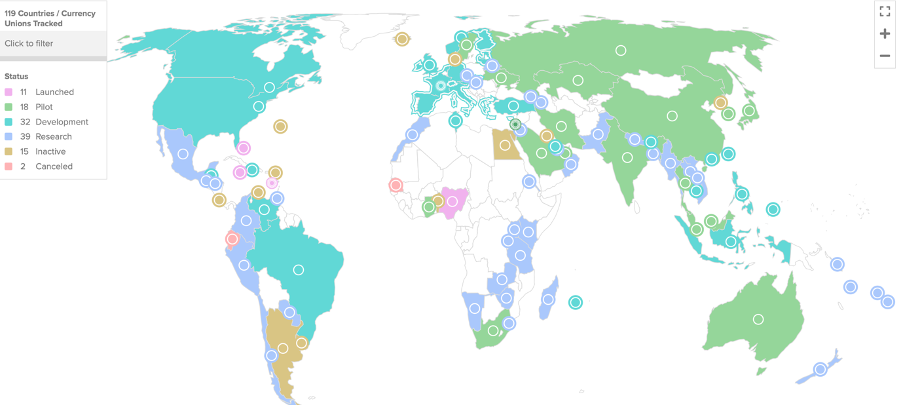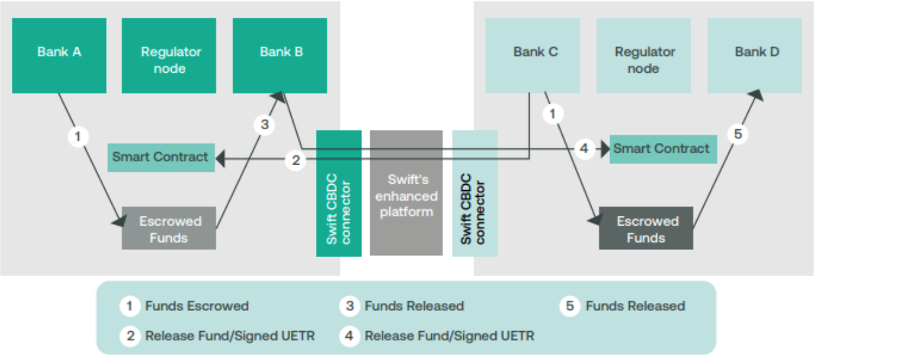Central Bank Digital Currencies or CBDCs developments continue to run in full swing. Of late, renowned banking institutions saw “clear potential and value” in SWIFT’s experimental CBDC Connector pilot tests.
Central Bank Digital Currencies have the potential to offer several benefits to the financial system. Even the economy as a whole. Regions collaborating with banking institutions from China to Russia to other developed nations have taken significant steps under this cohort. In fact, according to the Atlantic Council CBDC tracker, 114 countries, representing over 95 percent of global GDP, are exploring it.
Eleven countries, including Nigeria and the Bahamas, have already launched their iterations.

In the ongoing year, over 20 countries will take significant steps towards piloting it. Australia, Thailand, Brazil, India, South Korea, and Russia intend to continue or begin pilot testing in 2023. The ECB is also likely to start a pilot next year.
CBDC Benefits
Some potential benefits of CBDCs explain different geography implementing routes to welcome it.
Some of the benefits include:
- Increased efficiency and speed of payments: CBDCs can make payments faster, cheaper, and more secure than traditional payment systems. This could boost economic activity and productivity.
- Financial inclusion: CBDCs can improve financial inclusion by providing access to banking services to the unbanked and underbanked populations. CBDCs can be accessed by anyone with a smartphone, even without a traditional bank account.
- Reduced transaction costs: CBDCs can reduce transaction costs for individuals and businesses, leading to cost savings and increased competitiveness.
- Improved monetary policy: CBDCs can enhance monetary policy by allowing central banks to implement and control monetary policy more. This can result in increased stability of the financial system and the economy.
- Combating illicit activities: CBDCs can potentially help combat illegal activities such as money laundering and terrorism financing by providing greater transparency and traceability of transactions.
Given these potential benefits, it is unsurprising that many central banks worldwide are actively researching and experimenting with CBDCs.
Sponsored SponsoredPositive Momentum for CBDCs in 2023
Unsurprisingly, financial institutions are working rapidly to implement/project utilities to CBDCs. Be it retail or wholesale CBDC category. This is also evident in a press release shared with BeInCrypto. Herein, the bank messaging platform Society for Worldwide Interbank Financial Telecommunications, or SWIFT, gave an update on the situation.
Per the report, 18 central and commercial banks found “clear potential and value” in the API-based CBDC connector after a comprehensive review. Consequently, it witnessed positive results in its pilot test linking different central bank digital currencies. The summary comes after nearly 5,000 CBDC-to-CBDC and CBDC-to-fiat simulations over 12 weeks.
As a result, ensuring that CBDC can be used for cross-border payments. In addition, SWIFT plans to run a second phase of its CBDC sandbox. Further, developing its “CBDC interlinking solution into a beta version for payments with enhanced atomicity.”

“Central and commercial bank participants expressed strong support for the solution’s continued development, noting that it enabled seamless exchange of CBDCs, even those built on different platforms.”
Participants include the Royal Bank of Canada, Banque de France, Société Générale, BNP Paribas, Monetary Authority of Singapore, HSBC, Deutsche Bundesbank, NatWest, and more. According to a recent OMFIF Digital Monetary Institute survey that was shared with BeInCrypto, 24% of central banks will introduce a digital currency within the next couple of years.
SponsoredScenarios Around the Development
While the foundation is laid out, some issues might still exist. For instance, interoperability is critical for developing CBDCs and the financial industry. Interoperability refers to the ability of different systems, platforms, and applications to work together seamlessly without any compatibility issues or barriers.
In this context, interoperability is essential because it allows for the exchange of digital currencies across different platforms and networks. This means that users can seamlessly transfer funds between other wallets, payment systems, and even across different CBDCs issued by various central banks.
The lack of interoperability could result in silos of digital currencies, where users are limited to transacting within a specific network or platform. This would hinder the potential benefits such as faster and cheaper payments, financial inclusion, and enhanced security.
Lewis Sun, global head of domestic and emerging payments at HSBC, told BeInCrypto:
Sponsored Sponsored“Interoperability is key to realizing the potential of CBDCs to deliver real-time cross-border payments. While interest in CBDCs is growing, so is the risk of fragmentation as a widening range of technologies and standards is being experimented with.”
Digital Currencies May Lack a Key Ingredient
It is essential to note that these also pose certain risks and challenges, such as privacy concerns, cybersecurity risks, and potential disruption to the existing financial system. Therefore, careful consideration and analysis are necessary before implementing CBDCs. Nick Anthony, a policy analyst at the Cato Institute, regarding the ongoing situation commented:
“A CBDC could undermine both the foundation and future of financial markets by reducing credit availability, disintermediating banks, and challenging the rise of cryptocurrency.”
He further called it ‘the single largest assault’ on financial privacy since establishing the Bank Secrecy Act and the third-party doctrine. Remember, these digital forms of traditional currencies are issued and backed by central banks. While digital currencies have the potential to bring about many benefits, they also come with several potential disadvantages.
Concerns Around CBDC Innovation
Here are some of the main disadvantages of CBDCs:
- Security Risks: CBDCs could be vulnerable to security risks such as cyber-attacks, hacking, and theft. These risks could lead to the loss of funds for individuals and businesses and undermine the financial system’s stability.
- Privacy Concerns: CBDCs could also raise privacy concerns, as central banks would have access to detailed information about all transactions. This could compromise the privacy of individuals and businesses and raise concerns about government surveillance.
- Disintermediation of Banks: CBDCs could decrease demand for traditional bank deposits, as individuals and businesses could hold their funds directly with the central bank. This could undermine the role of banks in the financial system and lead to a concentration of power in the hands of central banks.
- Economic Disruption: CBDCs could also cause economic disruption, as they could undermine the profitability of banks and other financial institutions. This could lead to a contraction of credit and a reduction in economic activity.
- Technical Challenges: Implementing CBDCs could also pose technical challenges, as it would require significant investment in technology infrastructure and the development of new regulatory frameworks.
- Adoption Challenges: CBDCs could face challenges in adoption, particularly in countries where cash is still widely used and where there is limited access to digital technologies. This could exacerbate existing inequalities and exclude certain groups from the financial system.
It’s worth noting that some of these disadvantages are still speculative, and much will depend on the design and implementation. However, policymakers and stakeholders must consider these potential risks as they progress with such initiatives.

